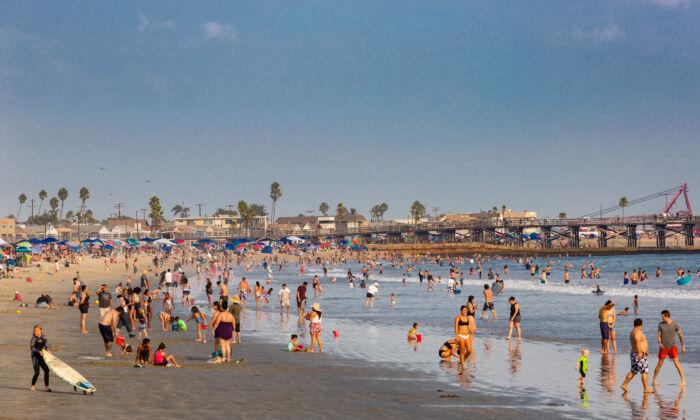LOS ANGELES—The Los Angeles and Long Beach ports located in the San Pedro Bay are expected to remain backlogged until at least next summer due to a record number of container ships arriving, Long Beach Port Deputy Executive Director Noel Hacegaba told The Epoch Times.
Hacegaba said the extended port congestion may negatively impact the global supply chain.
The two ports, with cargo that passes through its docks reaching all 435 congressional districts, is expected to accept a whopping 20 million container units this year—a 16 percent increase over the 17.5 million it took in 2020 and 16 million in 2019.
Currently, there are 63 container ships anchored in the bay waiting to berth, a slight decrease from the record number of 73 anchored ships last week, although still far beyond what is usual. The 63 ships at anchorage are carrying at least 750,000 container units among them.

The uptick in ships at the port was first noticed back in July 2020, when manufacturing in Asia began to increase again after slowing down due to the pandemic. Additionally, Americans began spending their money on goods instead of services due to increased time spent at home.
The slowdown in processing time for container ships has been felt across the supply chain, with stores often needing to wait months to stock up on certain items.
Currently, the average time a vessel waits at anchorage is five to eight days, and once at berth, takes another three to five days to discharge all its containers onto land.
In an effort to decrease processing time, the Long Beach Port has worked to increase the rate of unloading the containers.
“We are literally working around the clock to get those ships to berth and get those containers unloaded so that the goods can make their way to the store shelves,” Hacegaba said. “Just last week, we launched a 24-hour pilot program, and the idea is to keep the terminals open 24 hours to maximize the opportunities to move those containers out of the port throughout the day and throughout the night.”

In addition to expanding operating hours, the port is looking to address supply chain issues by activating vacant land within the port complex.
In January, the port activated 17 acres of space to serve as a temporary staging site for containers that had yet to be picked up by trucks, and that space has now grown to 65 acres. Utilizing the space, the terminals are able to move the containers as soon as they’re off the ship in order to allow more ships to berth, Hacegaba said.
While the port has done what it can to expand operations, it can only go so far without the rest of the supply chain adjusting to allow for extra cargo. Truckers, and warehouse space to hold the merchandise, are operating in a limited capacity, adding to bottlenecks in the chain.
“We’re encouraging all segments of the supply chain to maximize hours of operation and maximize resources, because the truck driver shortage existed before the pandemic, but now we also have a labor shortage at the warehouses. So in our view, it’s even more reason to expand hours of operation, because we need those facilities open, and we need those trucks to be moving, and we need all the equipment to be circulating in the supply chain,” Hacegaba said.
While the supply chain continues to ramp up to accommodate the goods, cost is definitely a factor affecting how fast the chain will adjust.
“If you were to ask me, ‘Why is the supply chain not 24/7 to date,' I would say cost is probably one of the major factors. But when you consider the situation we’re in right where you have 60 ships in anchorage, you have six- to eight-month delays of goods arriving to stores, the question we have to ask is what’s the cost of not having” the merchandise in stores, he said.
“So it’s going to be incremental, it’s going to be something that’s going to be done over time. We don’t expect the supply chain to readjust overnight. However, we hope that this pilot program we launched last week will serve as a catalyst to get the broader supply chain moving in that direction.”

Jumpstarting the supply chain after it originally slowed down during the pandemic may be more difficult than imagined, according to Salvatore Mercogliano, an associate professor of history at Campbell University in North Carolina and adjunct professor at the U.S. Merchant Marine Academy.
Mercogliano said the flow of goods is like cars going down a freeway—when traffic is flowing, everything moves nicely. But if there’s a traffic jam, it takes a long time to get that flow back to normal even after the initial issue is dealt with.
“We have that stoppage just due to COVID, and what happened is now we’re catching up,” he said. “And so all these goods are now flowing across, but the problem is you can offload these vessels faster than the goods can get off the terminals.”
Another big limitation right now is the chassis, which are the back ends of the trucks that the containers sit on, Mercogliano said. Like other parts of the supply chain, the increased demand has caused an increased need for chassis.
“And so now you literally have truck drivers arriving at the port of LA and Long Beach, and the containers are there, the trucks are there, but there’s nothing to pull [the containers] on,” he said.





